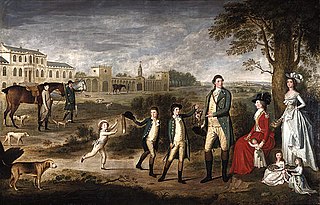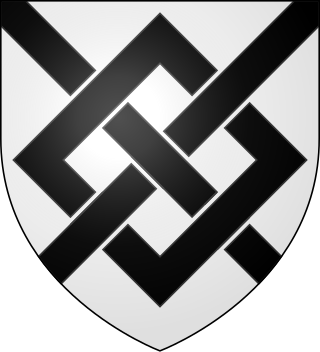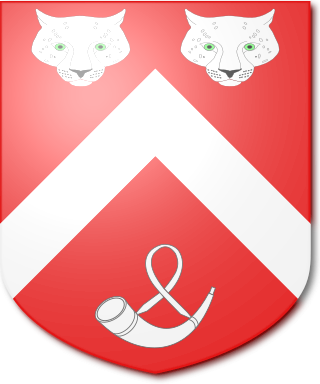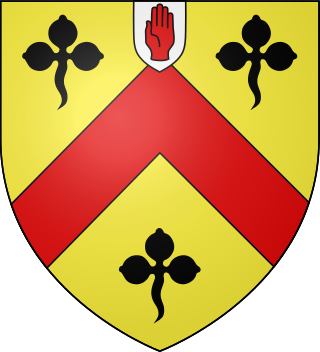
There have been five baronetcies of the United Kingdom created for a person with the surname Erskine, two in the Baronetage of Nova Scotia, one in the Baronetage of Great Britain and two in the Baronetage of the United Kingdom. Two of the creations are extant as of 2010.
There have been four baronetcies for persons with the surname Blake, one in the Baronetage of Ireland, two in the Baronetage of Great Britain and one in the Baronetage of the United Kingdom. Two of the creations are extant as of 2010. The Blake Baronetcy, of Menlough in the County of Galway, was created in the Baronetage of Ireland on 10 July 1622 for Valentine Blake, Mayor of Galway in 1611 and 1630 and a member of the Irish House of Commons for County Galway. His grandfather Thomas Blake had preceded him as Mayor. The second Baronet was a member of the Irish Parliament for Galway Borough. The third Baronet represented both County Galway and Galway Borough in Parliament. The sixth Baronet was a member of the Irish House of Commons for County Galway. He was the first Catholic gentlemen of distinction to join William of Orange. The twelfth Baronet represented Galway Borough in the British House of Commons. The fourteenth Baronet was high sheriff of County Galway in 1872. See also the Blake Baronetcy of Twizell Castle below.

There have been three baronetcies created for persons with the surname Kinloch, two in the Baronetage of Nova Scotia and one in the Baronetage of the United Kingdom. Two of the creations are extant as of 2010.
The Douglas of Glenbervie, Kincardine Baronetcy was created on 28 May 1625 in the Baronetage of Nova Scotia.

There have been three baronetcies created for members of the Vernon family.
There have been four baronetcies created for persons with the surname Hall, one in the Baronetage of Nova Scotia and three in the Baronetage of the United Kingdom. Three of the creations are extant as of 2010.
There have been two baronetcies created for persons with the surname Bethune, one in the Baronetage of Nova Scotia and one in the Baronetage of the United Kingdom.
There have been two Cockburn baronetcies in the Baronetage of Nova Scotia.
There have been several Murray Baronetcies, all created in the Baronetage of Nova Scotia. Four of these baronetcies are extant.
There have been three baronetcies created for persons with the surname Foulis, one in the Baronetage of England and two in the Baronetage of Nova Scotia.
There have been four baronetcies created for people with the surname Innes, three in the Baronetage of Nova Scotia and one in the Baronetage of the United Kingdom. Three of the creations are extant as of 2010.
There have been four baronetcies created for persons with the surname Seton, all in the Baronetage of Nova Scotia. As of 2008 one creation is extant, one dormant and two extinct.
Sir John Hamilton-Dalrymple, 5th Baronet was a Scottish politician and the MP for Haddington Burghs between 1805 and 1806. He was the second son of Sir Hew Dalrymple, 3rd Baronet, and the younger brother of Sir Hew Dalrymple-Hamilton, 4th Baronet.

There have been four baronetcies created for members of the Slingsby family who settled at Scriven Hall, Scriven, Knaresborough, Yorkshire in the 14th century.
The O'Carroll baronetcy, of Denton, Yorkshire, was a title in the Baronetage of Great Britain that was apparently created in or before 1712 for the military commander Daniel O'Carroll, although there is no official record of its creation. The first baronet later became a Lieutenant-General in the British Army. The fourth baronet was British Resident at Saxe-Weimar. The title became either extinct or dormant on the death of the sixth baronet in 1835.
The Menzies Baronetcy, of Castle Menzies in the County of Perth, was a title in the Baronetage of Nova Scotia. It was created on 2 September 1665 for Alexander Menzies. The title became extinct on the death of the eighth Baronet in 1910. It was unsuccessfully claimed between 1914 and 1917 by David Prentice Menzies, of Plean Castle, Stirlingshire, who claimed to be the nearest lawful heir male of line of Captain James Menzies.
The Mill Baronetcy, of Camois Court in the County of Sussex, was a title in the Baronetage of England. It was created on 31 December 1619 for John Mill, subsequently Member of Parliament for Southampton. The third Baronet was High Sheriff of Hampshire in 1685. The fifth Baronet was member of parliament for Midhurst, Penrhyn and Horsham. The sixth Baronet sat as a Knight of the Shire for Hampshire. The title became extinct on the death of the tenth Baronet in 1835.
Three Steuart baronetcies were given to three brothers, the first, fourth, and seventh of the seven sons of Sir James Steuart, knight, Lord Provost of Edinburgh, who died in 1681.

The Abdy baronetcy, of Felix Hall, in the County of Essex, was created in the Baronetage of England on 14 July 1641 for Thomas Abdy who was High Sheriff of Essex. The title became extinct in 1868.

The Gordon baronetcy of Earlston, Kirkcudbrightshire, was created in the Baronetage of Nova Scotia for William Gordon of Afton, son of William Gordon of Earlston, a Covenanter. He was an army officer, a soldier of fortune under Frederick I of Prussia who took part in Monmouth's Rebellion and the Williamite Wars. He was succeeded by his elder brother Alexander Gordon of Earlston.